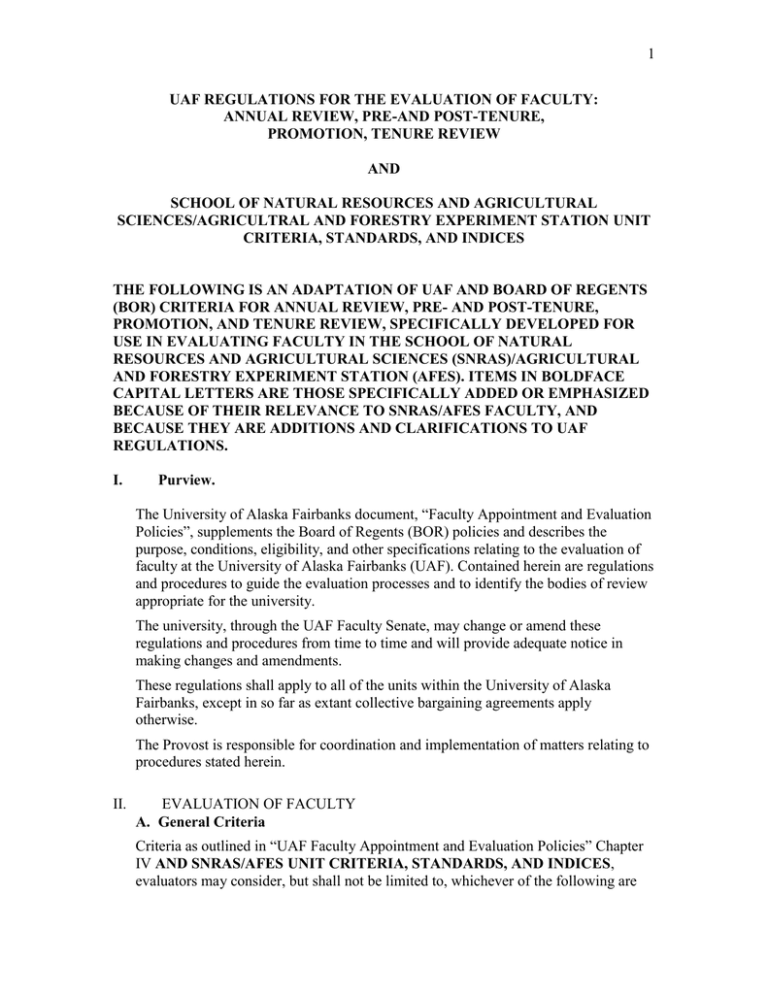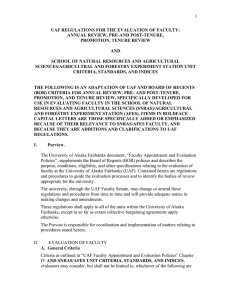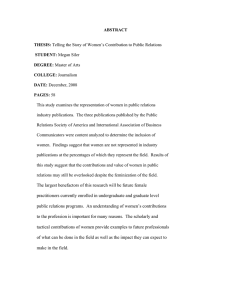1 UAF REGULATIONS FOR THE EVALUATION OF FACULTY: ANNUAL REVIEW, PRE-AND POST-TENURE,
advertisement

1 UAF REGULATIONS FOR THE EVALUATION OF FACULTY: ANNUAL REVIEW, PRE-AND POST-TENURE, PROMOTION, TENURE REVIEW AND SCHOOL OF NATURAL RESOURCES AND AGRICULTURAL SCIENCES/AGRICULTRAL AND FORESTRY EXPERIMENT STATION UNIT CRITERIA, STANDARDS, AND INDICES THE FOLLOWING IS AN ADAPTATION OF UAF AND BOARD OF REGENTS (BOR) CRITERIA FOR ANNUAL REVIEW, PRE- AND POST-TENURE, PROMOTION, AND TENURE REVIEW, SPECIFICALLY DEVELOPED FOR USE IN EVALUATING FACULTY IN THE SCHOOL OF NATURAL RESOURCES AND AGRICULTURAL SCIENCES (SNRAS)/AGRICULTURAL AND FORESTRY EXPERIMENT STATION (AFES). ITEMS IN BOLDFACE CAPITAL LETTERS ARE THOSE SPECIFICALLY ADDED OR EMPHASIZED BECAUSE OF THEIR RELEVANCE TO SNRAS/AFES FACULTY, AND BECAUSE THEY ARE ADDITIONS AND CLARIFICATIONS TO UAF REGULATIONS. I. Purview. The University of Alaska Fairbanks document, “Faculty Appointment and Evaluation Policies”, supplements the Board of Regents (BOR) policies and describes the purpose, conditions, eligibility, and other specifications relating to the evaluation of faculty at the University of Alaska Fairbanks (UAF). Contained herein are regulations and procedures to guide the evaluation processes and to identify the bodies of review appropriate for the university. The university, through the UAF Faculty Senate, may change or amend these regulations and procedures from time to time and will provide adequate notice in making changes and amendments. These regulations shall apply to all of the units within the University of Alaska Fairbanks, except in so far as extant collective bargaining agreements apply otherwise. The Provost is responsible for coordination and implementation of matters relating to procedures stated herein. II. EVALUATION OF FACULTY A. General Criteria Criteria as outlined in “UAF Faculty Appointment and Evaluation Policies” Chapter IV AND SNRAS/AFES UNIT CRITERIA, STANDARDS, AND INDICES, evaluators may consider, but shall not be limited to, whichever of the following are 2 appropriate to the faculty members’ professional obligation: mastery of subject matter; effectiveness in teaching; achievement in research, scholarly, and creative activity; effectiveness of public service; effectiveness of university service; demonstration of professional development and quality of total contribution to the university. For purposes of evaluation at UAF, the total contribution to the university and activity in the areas outlined above will be defined by relevant activity and demonstrated competence from the following areas: 1) effectiveness in teaching; 2) achievement in scholarly activity; and 3) effectiveness of service. EVALUATIONS SHOULD BE CONSISTENT WITH AN INDIVIDUAL FACULTY MEMBER’S JOB DESCRIPTION AND WORKLOAD ASSIGNMENT. THIS APPLIES TO TENURED AND TENURE-TRACK FACULTY AND TO NON-TENURE TRACK FACULTY SUCH AS RESEARCH FACULTY. B. Criteria for Instruction A central function of the university is instruction of students in formal courses and supervised study. Teaching includes those activities directly related to the formal and informal transmission of appropriate skills and knowledge to students. The nature of instruction will vary for each faculty member, depending upon workload distribution and the particular teaching mission of the unit. Instruction includes actual contact in classroom, correspondence or electronic delivery methods, laboratory or field and preparatory activities, such as preparing for lectures, setting up demonstrations, and preparing for laboratory experiments, as well as individual/independent study, tutorial sessions, evaluations, correcting papers, and determining grades. Other aspects of teaching and instruction extend to undergraduate and graduate academic advising and counseling, training graduate students and serving on their graduate committees, particularly as their major advisor, curriculum development, and academic recruiting and retention activities. 1. Effectiveness in Teaching Evidence of excellence in teaching may be demonstrated through, but not limited to, evidence of the various characteristics that define effective teachers. Effective teachers WILL DEMONSTRATE THE FOLLOWING CHARACTERISTICS PERTINENT TO THEIR WORKLOAD ASSIGNMENT: a. are highly organized, plan carefully, use class time efficiently, have clear objectives, have high expectations for students; b. express positive regard for students, develop good rapport with students, show interest/enthusiasm for the subject; c. emphasize and encourage student participation, ask questions, frequently monitor student participation for student learning and teacher effectiveness, are sensitive to student diversity, CREATE AN ATMOSPHERE OF OPENNESS IN THE CLASSROOM THAT ENCOURAGES STUDENTS TO FREELY EXPRESS THEIR OWN IDEAS AND VIEWPOINTS; 3 d. emphasize regular feedback to students and reward student learning success; e. demonstrate content mastery, discuss current information and divergent points of view, relate topics to other disciplines, deliver material at the appropriate level; f. regularly develop new courses, workshops and seminars and use a variety of methods of instructional delivery and instructional design, INCLUDING WEBBASED MATERIALS AND DISTANCE-DELIVERY TEACHING; g. may receive prizes and awards for excellence in teaching; h. DEMONSTRATE THOROUGH UNDERSTANDING OF UAF AND SNRAS ACADEMIC REQUIRMENTS IN ORDER TO FACILITATE EFFECTIVE ADVISING AND MENTORING OF INDIVIDUAL STUDENTS DURING THE TERM OF THEIR DEGREE PROGRAM. EVALUATION WILL BE BASED ON QUESTIONS ASK OF STUDENTS AT EXIT INTERVIEWS OR SURVEYS. i. DEMONSTRATE EFFECTIVE SERVICE AS MAJOR ADVISOR OR MEMBER OF SENIOR THESIS AND GRADUATE COMMITTEES; j. PROMOTE UNDERGRADUATE STUDENT INVOLVEMENT IN FACULTY SCHOLARLY PROJECTS. SPECIFIC SNRAS/AFES CRITERIA FOR TEACHING PERFORMANCE: ASSISTANT PROFESSOR: EVIDENCE OF HIGH QUALITY TEACHING AND A COMMITMENT TO A QUALITY TEACHING PROGRAM IN THE DEPARTMENT AS DEMONSTRATED THROUGH PEER, DEPARTMENT, AND/OR STUDENT TEACHING EVALUATION. ASSOCIATE PROFESSOR: EVIDENCE OF THE EXPECTED QUALITY OF INSTRUCTIONAL PERFORMANCE MAY INCLUDE (BUT IS NOT LIMITED TO) SUPERIOR CLASSROOM TEACHING AS DEOMONSTRATED BY TEACHING EVALUATIONS, COURSE AND/OR CURRICULUM DEVELOPMENT INCLUDING CONTEMPORARY AND RELEVANT MATERIAL THAT STIMULATES THE LEARNING PROCESS, NOVEL APPROACHES TO INSTRUCTION AND USE OF ASSIGNMENTS, AND EFFECTIVE GUIDING AND MENTORING OF INDIVIDUAL STUDENTS. PROFESSOR: MAJOR CONTRIBUTIONS TO THE INSTRUCTIONAL PROGRAM ARE EXPECTED. THESE CONTRIBUTIONS MAY INCLUDE (BUT ARE NOT LIMITED TO) EXCELLENT CLASSROOM TEACHING AS 4 DEOMONSTRATED BY TEACHING EVALUATIONS, MAJOR IMPROVEMENTS IN COURSE AND/OR CURRICULUM OFFERINGS, UPGRADING OF INSTRUCTIONAL TECHNIQUES, ABILITY TO MOTIVATE AND/OR INSPIRE STUDENTS. MUST PROVIDE EVIDENCE OF EXCELLENCE IN TRAINING AND MENTORING OF GRADUATE STUDENTS FOR FACULTY IN PROGRAMS THAT GRANT GRADUATE DEGREES. 2. Components of Evaluation Effectiveness in teaching will be evaluated through information on formal and informal teaching, course and curriculum material, recruiting and advising, training/guiding graduate students, etc., provided by: a. systematic student ratings, i.e. student opinion of instruction summary forms, and clientele response for extension of educational materials to constituents outside the University (if available), and at least two of the following: b. narrative self-evaluation. c. peer/department chair classroom observations. d. peer/department chair evaluation of course materials. C. Criteria for Research, Scholarly, and Creative Activity Inquiry and originality are central functions of a land grant/sea grant/space grant university and all faculty with a research component in their assignment must remain active as scholars. Consequently, faculty are expected to conduct research or engage in other scholarly or creative pursuits that are appropriate to the mission of their unit, and equally important, results of their work must be disseminated through media appropriate to their discipline. Furthermore, it is important to emphasize the distinction between routine production and creative excellence as evaluated by an individual’s peers at the University of Alaska and elsewhere. RESEARCHERS WHO RECEIVE FEDERAL AND STATE FORMULA FUNDS (SUCH AS HATCH AND MACINTIRE-STENNIS FUNDS) THROUGH THE AGRICULTURAL AND FORESTRY EXPERIMENT STATION (AFES) HAVE A SPECIAL MISSION TO CONDUCT RESEARCH WITH DIRECT APPLICATION TO GOVERNMENT AGENCIES, PRIVATE BUSINESSES, AGRICULTURAL AND FORESTRY PRODUCERS, NATURAL RESOURCE MANAGERS, EDUCATORS, AND OTHER RESEARCHERS IN ALASKA. THIS IS A FUNDAMENTAL OBLIGATION OF THE AFES TO THE PEOPLE OF ALASKA. EACH FACULTY MEMBER SO FUNDED IS EXPECTED TO DISSEMINATE THE RESULTS OF THEIR RESEARCH IN ACTIVITIES SUCH AS AFES PEER REVIEWED PUBLICATIONS, WORKSHOPS, SEMINARS, CONFERENCES, NEWSLETTERS, AND FORUMS DIRECTED SPECIFICALLY AT END 5 USERS, AS WELL AS IN APPROPRIATE JOURNALS, CONFERENCES, AND REPORTS TO THE FUNDING AGENCIES. 1. Achievement in Research, Scholarly, and Creative Activity Whatever the contribution, research, scholarly or creative activities must have one or more the following characteristics: a. They must occur in a public forum. b. They must be evaluated by appropriate peers. c. They must be evaluated by peers external to this institution so as to allow an objective judgment. d. They must be judged to make a contribution. 2. Components of Research, Scholarly and Creative Activity Evidence of excellence in research, scholarly, and creative activity may be demonstrated through, but not limited to: a. Books, reviews, monographs, bulletins, articles, proceedings, ELECTRONIC JOURNALS, INTERACTIVE ELECTRONIC PUBLICATIONS, MAPS, PHOTOGRAPHS and other scholarly works published by reputable journals, scholarly presses, and publishing houses that accept works only after rigorous review and approval by peers in the discipline AND EXTERNAL TO UAF. b. Competitive grants and contracts to finance the development of ideas; these grants and contracts being subject to rigorous peer review and approval. c. Presentation of research papers before learned societies that accept papers only after rigorous review and approval by peers. d. Exhibitions of art works at galleries; selection for these exhibitions being based on rigorous review and approval by juries, recognized artists, or critics. e. Performance in recitals or productions; selection for these performances being based on stringent auditions and approval by appropriate judges. f. Editing or refereeing articles or proposals for professional journals or organizations g. Scholarly reviews of publications, art works and performance of the candidate. h. Citations of research in scholarly publications. 6 i. Published abstracts of research papers. j. Reprints or quotations of publications, reproductions of art works, and descriptions of interpretations in the performing arts; these materials appearing in reputable works of the discipline. k. Prizes and awards for excellence of scholarship. l. Awards of special fellowships for research or artistic activities or selection of tours of duty at special institutes for advanced study. m. Development of processes or instruments useful in solving problems, such as computer programs, SOPHISTICATED COMPUTER MODELS THAT HELP IN THE UNDERSTANDING OF COMPLEX SYSTEMS, and systems for the processing of data, genetic plant and animal material, and where appropriate obtaining patents and/or copyrights for said development. n. PEER-REVIEWED PUBLICATIONS INTERNAL TO UAF, PUBLISHED BY AFES OR CES, INCLUDING CIRCULARS, BULLETINS, RESEARCH PROGRESS REPORTS, AND MISCELLANEOUS PUBLICATIONS. SPECIFIC SNRAS/AFES CRITERIA FOR RESEARCH PERFORMANCE: ASSISTANT PROFESSOR: EVIDENCE OF THE ABILITY TO ESTABLISH A VIABLE RESEARCH PROGRAM IN THE AREA OF SPECIALIZATION AND SHOW CREATIVITY AND PRODUCTIVITY IN RESEARCH. ASSOCIATE PROFESSOR: MUST HAVE ESTABLISHED A RESEARCH PROGRAM THAT PRODUCES ORIGINAL PUBLICATIONS IN THE PEERREVIEWED OR EDITORIAL BOARD REVIEWED, LITERATURE. DEMONSTRATED RECORD OF PRESENTATION OF RESEARCH RESULTS AT PROFESSIONAL MEETINGS, SUBMISSION OF RESEARCH PROPOSALS, AND ACQUISITION OF EXTERNAL RESEARCH FUNDING. PROFESSOR: DEMONSTRATE CONTINUED EXCELLENT RECORD OF PRESENTATION OF RESEARCH RESULTS AT PROFESSIONAL MEETINGS, SUBMISSION OF RESEARCH PROPOSALS, AND ACQUISITION OF EXTERNAL RESEARCH FUNDING. THE RESEARCH PROGRAM SHOULD HAVE PRODUCED HIGH IMPACT, ORIGINAL PUBLICATIONS IN THE PROFESSIONAL LITERATURE. THERE SHOULD BE A RECORD OF GRADUATE INVOLVEMENT FOR FACULTY IN PROGRAMS THAT GRANT GRADUATE DEGREES. 7 D. Criteria for Public and University Service and PROFESSIONAL SERVICE Public service is intrinsic to the land grant/sea grant/space grant tradition, and is a fundamental part of the university’s obligation to the people of its state. In this tradition, faculty providing their professional expertise for the benefit of the university’s external constituency, free of charge, is identified as “public service.” The tradition of the university itself provides that its faculty assume a collegial obligation for the internal functioning of the institution; such service is identified as “university service.” 1. Public Service Public service is the application of teaching, research, and other scholarly activity and creative activity to constituencies outside the University of Alaska Fairbanks. It includes all activities which extend the faculty member’s professional, academic, or leadership competence to these constituencies. It can be instructional, collaborative, or consultative in nature and is related to the faculty member’s discipline or other publicly recognized expertise. Public service may be systematic activity that involves planning with clientele and delivery of information on a continuing, programmatic basis. It may also be informal, individual, professional contributions to the community or to one’s discipline, or other activities in furtherance of the goals and mission of the university and its units. Such service may occur on a periodic or limited-term basis. PUBLIC SERVICE INCLUDES COOPERATION WITH AGENCIES ADMINISTERING NATURAL RESOURCE POLICIES, PUBLIC EDUCATION, AND RESPONSE TO THE PROBLEMS OF LOCAL INDUSTRY, AGRICULTURAL AND FORESTRY PRODUCERS, AND THE ALASKAN PUBLIC. Examples include, but are not limited to: a. Providing information services to adults and youth. b. Service on or to government or public committees. c. Service on accrediting bodies. d. Active participation in professional organizations. e. Active participation in discipline-oriented service organizations. f. UNPAID Consulting, ONE ON ONE CONSULTATION WITH CLIENTELE, SITE VISITATIONS TO AGENCIES, FARMS, AND PRODUCTION FACILITIES FOR PROBLEM-SOLVING CONSULTATION. g. Prizes and awards for excellence in public service. 8 h. Leadership of or presentations at CLIENTELE-ORIENTED workshops, conferences, or public meetings, FIELD DAYS, CONFERENCES, AND TOURS. i. Training and facilitating IN ONE’S DISCIPLINE IN WAYS TO BENEFIT CLIENTELE OR THE GENERAL PUBLIC. j. Radio and TV programs AND INTERVIEWS, newspaper articles and columns, publications, newsletters, films, computer applications, teleconferences and other educational media. k. Judging and similar educational assistance at science fairs, state fairs, and speech, drama, literary, and similar competitions. l. ACTIVE PARTICIPATION IN CONSTITUENCY ORGANIZATIONS. m. USER ORIENTED PRESENTATIONS AT WORKSHOPS, FIELD DAYS, CONFERENCES, AND TOURS,. n. PRODUCTION OF FACT SHEETS AND EXTENSION PUBLICATIONS FOR GENERAL INFORMATION. o. PARTICIPATION IN K-12 OUTREACH PROGRAMS SUCH AS GLOBE, MAP TEACH, MATH IN A CULTURAL CONTEXT, SCHOOL-YARD LTER , ALASKA RURAL RESEARCH PARTNERSHIPS, AND RELATED PROGRAMS.. p. PRESENTATIONS OUTSIDE ONE’S SPECIALTY BUT OF A PROFESSIONAL NATURE IN PUBLIC FORUMS SUCH AS COMMUNITY GROUPS, PROFESSIONAL GROUPS, GOVERNMENT BODIES, AND RELATED FORUMS, SUCH AS MEETINGS OF CIVIC ORGANIZATIONS. 2. University Service University service includes those activities involving faculty members in the governance, administration, and other internal affairs of the university, its colleges, schools, and institutes. It includes non-instructional work with students and their organizations. Examples of such activities include, but are not limited to; a. Service on university, college, school, institute, or departmental committees or governing bodies. b. Consultative work in support of university functions, such as expert assistance for specific projects. c. Service as department chair or term-limited and part-time assignment as assistant/associate dean in a college/school. d. Participation in accrediting reviews. 9 e. Service on collective bargaining unit committees or elected office. f. Service in support of student organizations and activities. g. Academic support services such as library and museum programs. h. Assisting other faculty or units with curriculum planning and delivery of instruction, such as serving as guest lecturer. i. Mentoring NEW FACULTY. j. Prizes and awards for excellence in university service. 3. PROFESSIONAL SERVICE a. Editing or refereeing articles or proposals for professional journals or organizations. b. Active participation in professional organizations AND PROEFESSIONAL MEETINGS, INCLUDING COMMITTEE CHAIR OR OFFICER OF PROFESSIONAL ORGANIZATIONS, SESSION ORGANIZER OR MODERATOR FOR PROFESSIONAL MEETINGS, AND RELATED ACTIVITIES c. Active participation in discipline-oriented service organizations. 4. Evaluation of Service Each faculty member’s proportionate responsibility in service shall be reflected in annual workload agreements. In formulating criteria, standards and indices for evaluation, promotion, and tenure, individuals units should include examples of service activities and measures for evaluation appropriate for that unit. Excellence in public, university, and PROFESSIONAL service may be demonstrated through, e.g., appropriate letters of commendation, recommendation, and/or appreciation, certificates and awards, INVITATIONS TO SPEAK AT CLIENTELE MEETINGS/CONFERENCES, and other public means of recognition for services rendered. ASSISTANT PROFESSOR: SHOULD EMPHASIZE PUBLIC SERVICE, LIMITED UNIVERSITY SERVICE, AND PROFESSIONAL SERVICE IN ACCORDANCE WITH DISCIPLINE STANDARDS AND INDIVIDUAL WORKLOAD. ASSOCIATE PROFESSOR: CONTRIBUTIONS TO THE DEPARTMENT AND THE UNIVERSITY, CONTRIBUTIONS TO THE PUBLIC IN THE FACULTY MEMBER’S AREA OF EXPERTISE, AND SERVICE TO THE FACULTY MEMBER’S PROFESSION ARE EXPECTED. PROFESSOR: EVIDENCE OF LEADERSHIP IN THE SERVICE AREA IS EXPECTED AND MAY INCLUDE, BUT IS NOT LIMITED TO, SERVICE 10 AS COMMITTEE CHAIR, SESSION ORGANIZER, OFFICER OF PROFESSIONAL ORGANIZATIONS. EVIDENCE OF EXCELLENT CONTRIBUTIONS TO THE DEVELOPMENT OF DEPARTMENTAL AND/OR UNIVERSITY PROGRAMS AND EXCELLENT APPLICATION OF PROFESSIONAL EXPERTISE TO PROFESSIONAL OR PUBLIC PROCESSES AND ORGANIZATIONS.

